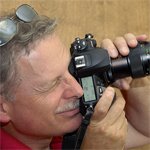Now, every Nikon DSLR body is a work of art. Even the diminuitive D40 is a stellar performer within its amateur-based capabilities. I bought one as a 'gap' body while waiting for the D300 to materialize, and it is surprising how many things it does well. Especially the image quality - better than several of its predecessors. But those consumer kit lenses will drive you nutty if you ever take a close look at what they are giving you.
So where is the solution? That's simple. Give me $1500 - $2000 and I'll hand over a pro quality Nikkor that will (1) put some meat on your mitts and, (2) reward you with pristine images every time you shoot. This is lensmaking - sharp, sharp, everything is sharp. No excuses and ballyhoo about antialias filters and uberzoom ranges wider than the Equator. Nope - just good glass, man.
Our Test Lens
So. Back to the 135/2.8 Nikkor-Q. What's your point, you say? Just this. As a far-from-heralded classic optical design - in fact, a converted pre-AI lens at that - the following images prove that good lenses have been available for decades. Using my modest little D40, I shot this series of test images wide open at f2.8, midway at f8, and stopped down to f16. The subject was chosen to allow detail and contrast to be easily evaluated - bare concrete is as bland as it gets, but when it shoots well you've done something right.
The subject is about 60 feet away (infinity) and you're looking at the 100% cropped section. No postprocessing has been done inside or outside the camera. Let's look at some pictures:

f2.8 @ infinity

f8 @ infinity

f16 @ infinity
As you can see, this early-1970's Nikkor is superb across the entire range of f-stops. It will outshoot every Nikkor zoom under $1000 - nd do it at a cost of $75-$120 bucks.
Icing on the Cake
Just to add another layer of evidence, here's an image using a Kenko Pro 300 DG 1.4X Teleconverter with the 135/2.8 Nikkor-Q. Factoring in the digital 1.5X conversion, the Nikkor-Q grows from a 202/2.8 into a stronger 283/4 telephoto. If these two unlikely partners can shoot well together, you've just upped the ante for superb photography by a whopping $125! Let's see what the camera shows us...

effectively f16 @ infinity (f8 w/ teleconverter)
Just as important as infinity focus is close range shooting. Can an old Nikkor pass that test too?

Here's another center crop of an image shot at less than three feet...

... and here's the center of that crop. Any questions?
The Nikkors of old had awesome contrast, sharpness and an imaging elegance that today's technology is slowly leaching out of our glass designs. Didjaknow, for example, that internal focusing, aspherical elements and other 'advances' actually increase distortion, CA and other anomolies in modern consumer optics? Combined with sloooow f4 and f5.6 maximum apertures, this explains the poor wide open performance, edge of field softness and slower AF response in today's consumer zooms. Sadly, even modern primes are not the match of their grandparents as plastic and offshore manufacturing take their toll.
Regarding lens speed, there's no such thing as a slow AI. Several of the 1.8 versions shoot very well wide open and represent the best value in AI's - the 1.4 and faster designs offer little more than a brighter viewfinder image with soft images until you're 2 stops down in many cases. What will you have to spend to get that kind of speed in a 'modern' lens? Four figures at least. Before you shell out the big bucks again on a 'better' lens than what you already have, take a look at the manual focus Nikkors for your architectural, scenic and portrait work.
You can still buy Nikkor-Q (and other pre-AI), AI and AI-S lenses as used equipment. In practical terms, any AI will improve your image quality - even the slowest ones. But the introduction of a full frame FX sensor in the D3 is going to exacerbate your opportunities as prices on these optical gems are escalating rapidly. Once the full frame mentality becomes fertile, the run on AI and AI-S Nikkors could be worse than weekend shoppers on the blue light special aisle at Kmart.
Looking for a new standard for your personal expectations in digital photography? It's been here all along...



No comments:
Post a Comment